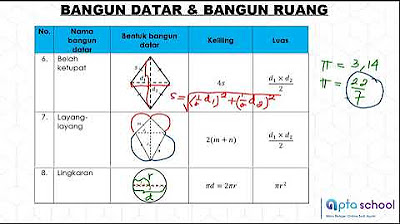3D Geometry | Equation of Plane & Angle Between Plane | By Gajendra Purohit
Summary
TLDRIn this educational video, Gajendra Purohit introduces the topic of 3D geometry, focusing on planes, cones, spheres, and cylinders. He explains various forms of the equation of a plane, including intercept, normal, point, and three-point forms. The video also covers calculating the angle between two planes and determining the perpendicular distance from a point to a plane. With clear examples and step-by-step solutions, the lesson is designed to help students understand and apply these fundamental concepts of 3D geometry, especially for those preparing for competitive exams in engineering mathematics.
Takeaways
- 😀 The YouTube channel focuses on engineer mathematics for BSc students, with a special emphasis on competitive exams.
- 😀 The video covers topics related to 3D geometry, including the concepts of plane, cone, sphere, and cylinder.
- 😀 The lesson starts with the basic definition of a plane and its relation to three-dimensional space.
- 😀 The video discusses different forms of the equation of a plane, such as intercept form, normal form, point form, and three-point form.
- 😀 The intercept form of a plane is explained, drawing parallels to the straight-line intercept form in two dimensions.
- 😀 The normal form of a plane is explained with a focus on the perpendicular distance from the origin, represented by 'p'.
- 😀 One-point form and three-point form of a plane's equation are discussed, including how to derive the constants.
- 😀 The video covers how to calculate the equation of a plane when given direction ratios and direction cosines.
- 😀 The angle between two planes is explained, along with formulas for determining if the planes are perpendicular, parallel, or neither.
- 😀 The length of the perpendicular from a point to a plane is explained, with a formula provided to solve such problems.
- 😀 The video encourages students to engage with problems through the comment section, promoting interaction and further learning.
Q & A
What is the focus of the video tutorial?
-The video tutorial focuses on teaching the concepts of 3D geometry, specifically dealing with planes, including various forms of plane equations, the angle between two planes, and the perpendicular distance from a point to a plane.
What is a plane in the context of 3D geometry?
-In 3D geometry, a plane is a flat surface that extends infinitely in all directions. It is defined by at least two points, and any line joining those two points within the surface should also lie on the plane.
What are the different forms of the equation of a plane discussed in the video?
-The video covers various forms of the equation of a plane, including the intercept form, normal form, one-point form, and three-point form.
How is the intercept form of a plane equation represented?
-The intercept form of a plane equation is similar to the straight-line intercept form but applied to three-dimensional geometry. It represents the plane's intercepts with the x, y, and z axes.
What is the normal form of a plane equation?
-The normal form of a plane equation involves a perpendicular distance (denoted as 'p') from the origin to the plane. The equation uses direction cosines and the perpendicular distance to represent the plane.
What is one-point form and three-point form of the plane equation?
-The one-point form represents a plane passing through a given point, while the three-point form represents a plane passing through three given points. These forms help derive the equation of the plane based on known points.
How do you find the direction ratios and direction cosines of a plane?
-To find the direction ratios (a, b, c) of a plane, you need to compute the direction cosines (l, m, n), which are the cosines of the angles between the normal vector to the plane and the coordinate axes. The direction ratios are used in the equation of the plane.
What is the formula for the angle between two planes?
-The formula for the angle between two planes is derived from the dot product of their normal vectors. If the planes are perpendicular, the angle is 90 degrees, and if they are parallel, the angle is 0 degrees.
How can you determine if two planes are parallel or perpendicular?
-Two planes are perpendicular if the dot product of their normal vectors is zero. If the normal vectors are scalar multiples of each other, the planes are parallel.
What is the formula for the perpendicular distance from a point to a plane?
-The formula for the perpendicular distance from a point (x₀, y₀, z₀) to a plane Ax + By + Cz + D = 0 is given by: |Ax₀ + By₀ + Cz₀ + D| / √(A² + B² + C²). This distance measures the shortest distance from the point to the plane.
Outlines

Dieser Bereich ist nur für Premium-Benutzer verfügbar. Bitte führen Sie ein Upgrade durch, um auf diesen Abschnitt zuzugreifen.
Upgrade durchführenMindmap

Dieser Bereich ist nur für Premium-Benutzer verfügbar. Bitte führen Sie ein Upgrade durch, um auf diesen Abschnitt zuzugreifen.
Upgrade durchführenKeywords

Dieser Bereich ist nur für Premium-Benutzer verfügbar. Bitte führen Sie ein Upgrade durch, um auf diesen Abschnitt zuzugreifen.
Upgrade durchführenHighlights

Dieser Bereich ist nur für Premium-Benutzer verfügbar. Bitte führen Sie ein Upgrade durch, um auf diesen Abschnitt zuzugreifen.
Upgrade durchführenTranscripts

Dieser Bereich ist nur für Premium-Benutzer verfügbar. Bitte führen Sie ein Upgrade durch, um auf diesen Abschnitt zuzugreifen.
Upgrade durchführenWeitere ähnliche Videos ansehen
5.0 / 5 (0 votes)






